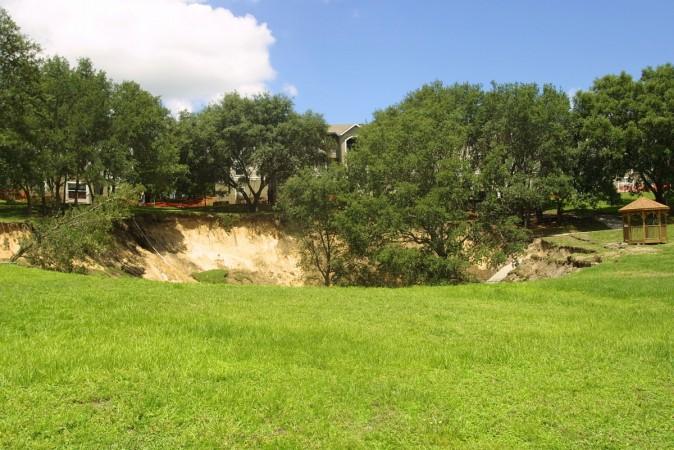
A sinkhole large enough to swallow a 15 storey building appeared overnight in the middle of a field in a Russian town. People in the region now fear that more sinkholes could follow.
The sinkhole appeared seemingly out of nowhere in the town of Neledino in the Nizhny Novgorod region. Luckily the town has about 111 residents, notes the Daily Mail. The report mentions that no one was hurt by the sudden appearance of this "gate to hell", as some locals are referring to it. The fear that another one could open up below a house and swallow people alive has left a sense of unease among the townsfolk.
Speaking to the Mail, one of the local residents spoke about how there is no guarantee that another one will not appear right in the middle of town or right under a house.
"Children have seen the hole and many are worried the same thing might suddenly happen when they are asleep at night," she said.
The giant sinkhole was reportedly first found by mushroom pickers in the area who then alerted the landlord. The police have cordoned off the entire area around the sinkhole to prevent people from getting too close to it. Reports suggest that the hole is about 32 metres wide and over 50 metres deep.
Terrifying: A giant sinkhole, measuring about 32 meters wide and 50 meters deep, suddenly opened up in the middle of a field in western Russia on July 25, 2018. The sinkhole was reportedly caused by groundwater erosion. No one was hurt due to its appearance. pic.twitter.com/gMwPrFRGGO
— People's Daily,China (@PDChina) July 30, 2018
"The ground collapsed in an agricultural field, which belongs to a private farmer, and is only two kilometres away from nearby homes," said a police spokesperson. "Based on the information we have, this field hasn't been used for the past two years."
Russia's Ministry for Emergency Situations has been reported to have arrived at the scene and started to investigate what caused this giant hole to suddenly open up, notes the report.
So far, investigators have found that the sinkhole was most likely caused by underground rocks getting washed away. They also clarified that it was not caused by explosions like other holes in the Arctic. The thawing permafrost in northern Russia is reportedly causing methane to build up underground and eventually explode, causing massive sinkholes.
How rare are sinkholes?
According to a report by American Geosciences, sinkholes are a fairly common occurrence. These holes in the ground are most common in what is known as a "karst terrain". Karst regions are characterised by the types of rock just below the land surface and they can be naturally dissolved by groundwater that circulates right through them.
Soluble rocks are the ones that include salt beds and domes, gypsum, limestone and other carbonate rock. When rainfall finds its way down into the soil, these rocks start dissolving, creating caverns and open spaces inside rocks that support the earth directly above them.
Sinkholes are sudden and dramatic because the surface -- what is visible -- usually stays intact for a long period of time, maybe even for hundreds of years. Then, suddenly, underground caverns get too big and rock becomes too feeble to hold up the weight of the soil above it.
This sinkhole, however, is the not the biggest natural depression in Russia. In fact, "The Grandfather," a sinkhole in the town of Berezniki, is over 228 m, over 310m wide, and 393 m long. It is located near one of the largest potash mines in the world.
















